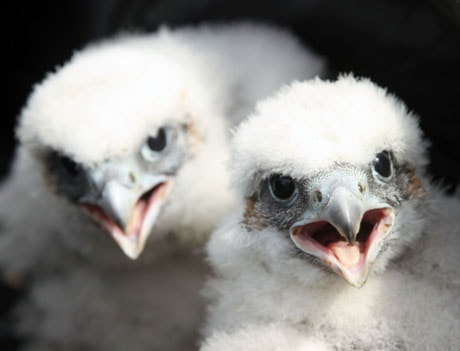Red Deer’s beloved peregrine falcon couple welcomed two chirping male chicks into their nest site and into their hearts early Saturday afternoon.
Provincial wildlife status biologist Gordon Court facilitated the heartwarming moment by bringing the two chicks from nests in Edmonton.
The female falcon, Perry, laid five eggs in early May at the nest site at the Highland Green Telus Tower.
But the couple broke and ate three of the eggs. They have continued to sit on the two remaining eggs, about 10 days longer than a typical hatching period.
Court said when there were fewer peregrine pairs in the province, Alberta Fish and Wildlife would frequently relocate chicks to new homes.
Now there are nearly 70 pairs in the province so the management of individual nests is not as important as it once was. However, the cool weather in May has contributed to this year’s poor peregrine hatching season.
In the past, DDT was the main culprit in the decline of the peregrines.
Female peregrines exposed to DDT do not produce enough calcium causing thin layers on the eggs making them easy to break.
But in the last 20 years there has been a consistent decline in DDT residue which explains why the peregrines and other species like the osprey and bald eagle are faring so well.
This particular female, however, has broken eggs in her nest twice in the last two years. Court said it is quite possible she has a pesticide problem and if the finger is pointed back at DDT it would be very rare in Alberta right now.
“We’re very interested in retrieving these eggs,” he said.
The eggs were removed and will be tested.
The chicks are about 24 days old and come from pairs who have other young in their nests.
Court said the pair will instinctively welcome the new additions to their family. He said that’s what has made the species so easy to manage.
“(The female) will be a little confused for a little bit because she will be looking for tiny chicks,” said Court. “She will try and brood them. She will try to feed them tiny meat but they will want big pieces.”
The young males typically start to fly at about 38 days.
“It will be quite the air show with two little males,” laughed Court. “They are the guys that fly first and they are the zippy little guys.”
Red Deer River Naturalist’s Judy Boyd is thrilled with the new additions. She hopes this will increase traffic on the Falcon Cam, available on the Advocate’s website www.reddeeradvocate.com
crhyno@www.reddeeradvocate.com
